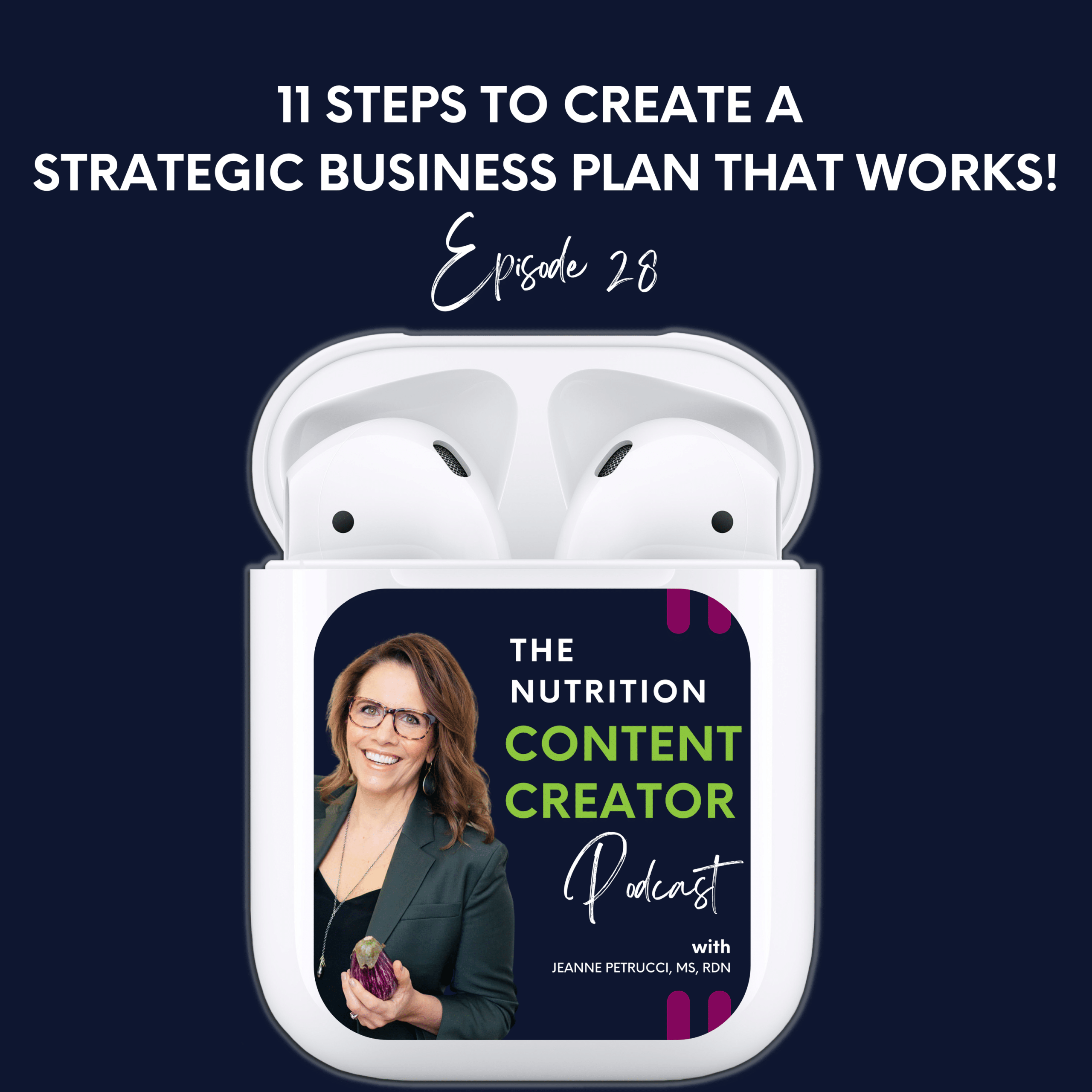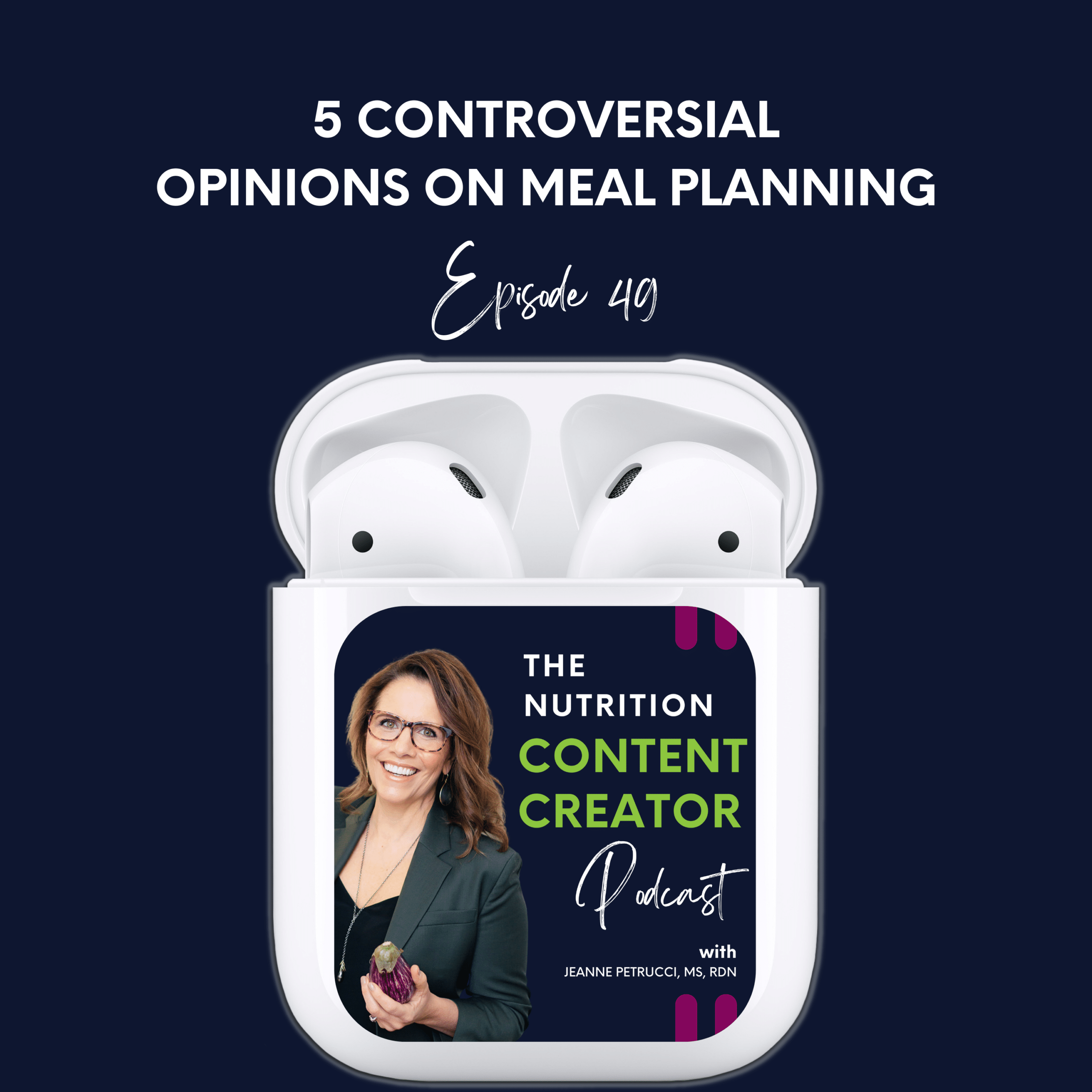28. 11 Steps to Create a Strategic Business Plan That Works!

You may have noticed that while we are “The Nutrition Content Creator Podcast”, we talk about other things that impact the THING [content creation]. Today is one of those times.
If you are here to learn about content creation for your practice and get the support you need, you have a business. One of the core best practices for running a business, big or small, is to have a strategic plan in place. As health and wellness professionals, most of us don’t have business training so we need to turn to other professionals or resources to support us.
I had a valuable experience recently that led me to select this topic today. In our private Facebook group, Yvonne noted that she was new to private practice and was looking to create a business plan – smart! But we didn’t have a template in the library. The funny thing is, we have all the ingredients in the library, which we’ll talk about today, but there was no template.
So I responded by telling Yvonne that I would dig up my old private practice business plan, circa 2017, and would create a template from it for her and the rest of the community.
The experience of reviewing my old business plan was a remarkable one. Reading my own words, which I have not read in years [shame on me] was so cool. The plan was my second [V2] as my first was strictly for growing a private practice. This one was when I started to pivot and explore the question, “What if I shared the resources and tools that worked in my practice with other practitioners? “
The original answer to that question was mission-based – if I share these tools and resources and make them top-shelf products, then I could have an even greater impact on the health of many communities, not just the one I served with my private practice.
So, as we review the Essential 11 Steps of a Strategic Business Plan, I will share with you my actual business plan from 2017 – it’s surreal as it is the blueprint for the work that I am doing now.
If you are thinking about hiring a business coach, I strongly encourage you to go through this process first. Given the predatory nature of some business coaching in the market today, having a strategic plan in place ensures that you are clear about your business direction. This clarity protects you from being swayed by anyone who doesn’t genuinely understand or respect your unique business dynamics.
Navigating private practice without a strategic plan is like sailing in the open ocean without a compass. You’ll almost certainly go off course without a plan in place, especially if the waters begin to get choppy.
Many people underestimate the value of having a strategic plan, viewing it as a static document that, once written, collects dust in a drawer. That’s a huge mistake. A well-crafted strategic plan is a dynamic blueprint that outlines your business objectives and the resources you’ll need to achieve them. It is a living document that will evolve as your practice does, and it remains an indispensable tool for steering your private practice in the direction you want it to go.
As we move through the 11 Essential Steps of your strategic plan, I will offer you an example from my 2017 business plan, the definition of the step, an immediate action you can take, and some insights into the importance of the step.
We’ll cover:
- 11 Steps to Create a Strategic Business Plan
Step One
Executive Summary: The Power of Summarization
An Executive Summary is a concise overview of your practice. It gives anyone reading it—be it a potential partner or an employee—an immediate grasp of who you are and what you aim to achieve. There are six parts to your Executive Summary: Mission statement, products and services, target market, competition, team members, and financial outlook. If the reader goes no further than the Executive Summary, they should still understand the fundamental elements of your business.
Let’s review examples for each part of your summary:
Mission Statement
Living Plate is a 501 (c)(3) organization dedicated to inspiring wellness through nutrition education that incorporates food experience. We are committed to providing nutrition professionals with programming and tools that include culinary instruction, both observational and experiential, in the nutrition care process.
💥Immediate Action
Take some time to write 2-3 sentences that cover who you are [your passion], who you serve, and how you serve them. You don’t have to get into the details – a high-level view is sufficient.
Use bullets to identify your offerings, target market[s], competition, team, and financial projections.
Products and services:
- Evidence-based MNT, insurance-based
- Comprehensive nutrition education programs that incorporate culinary instruction – provide programs by nutrition topic
- Revenue-generating digital meal planning program – provide plans by nutrition prescription [anti-inflammatory, diabetes, overweight, cancer, kidney, bariatric, etc.]
Target Market:
- Business-to-Consumer: Local community served at nutrition center and off-site programming
- Business-to-Business: Registered Dietitians – 10,000+ private practice in the US with projected 14% growth through 2025
- Business-to-Business-to-Consumer: Patients and clients of Registered Dietitians and other health and wellness professionals – market unknown, but with the rise in chronic disease, opportunities in nutrition interventions will continue to grow.
Competition:
- Little private practice competition – a few health coaches in town with limited practice
- Currently no organized distribution of nutrition education content. Mostly free downloads are offered through non-profits – poor quality and not branded
- Meal planning platforms marketed to dietitians that are algorithm-driven, screening by preference. No competitors are offering expert hand-curation of meal plans for specific nutrition prescriptions
Management and Care Team:
List your team members [contractors, interns, VAs, etc.]
- Jeanne Petrucci, MS, RDN – 20+ years as a culinary instructor. Completed clinical practice at Robert Wood Johnson Hospital. MS Nutrition Education, Columbia University
- RDN – Culinary dietitian, recipe developer, blogger
- RDN – Clinical dietitian with experience in oncology, kidney disease, and cardiac care, experience in research analysis, and program development
- RDN – Private Practice Dietitian with deep experience in billing for nutrition care for most health conditions
Financial Outlook – 3 years:
Include all possible streams of revenue. I included three at the time: Private Practice Revenue, Meal Plan REvenue, and Library Revenue. I listed the annual net revenue projected for each year.
Step 2
Core Values: Your North Star
Core values are the essence of your company’s identity. They represent the fundamental beliefs upon which your private practice is built, guiding your decision-making and influencing your culture. Essentially, they are your guiding stars that align your practice and keep everyone on the same page.
In healthcare, where the focus is on personal well-being, having strong core values is especially critical. Your values act as a promise to your clients, ensuring that they can trust the service they receive. They also guide your interactions with colleagues, partners, and even competitors.
💥Immediate Action: Crafting Your Core Values
- Self-Reflection: Spend some time reflecting on what matters most to you as a practitioner. What are the principles that you absolutely will not compromise on?
- Client Input: Sometimes it helps to consider what values your clients appreciate. You could send out a survey or ask for feedback.
- Team Discussion: If you have a team, involve them in the process. They’ll offer different perspectives that could be valuable.
- Be Specific: General values like ‘quality’ and ‘service’ are too vague. Aim for specificity like ’empowerment through education’ or ‘sustainable health solutions.’
- Limit the Number: Too many values can dilute their importance. Aim for around 3-5 key values.
- Make Them Memorable: Your core values should be easy to remember and resonate with both staff and clients.
- Communicate: Once established, make sure to communicate these values to your team and clients. They should be visible, perhaps even displayed in your office, and definitely on your website.
Here are my core values for my private practice:
Living Plate Core Values:
- Commitment: Provide innovative products and services to registered dietitians and healthcare professionals to use in practice
- Development: Design evidence-based programming and tools to meet the changing needs of communities
- Education: Enrich knowledge of team members through further education and training
- Evidence-based practice: Remain on top of current research and trends in the field
- Advocacy: Promote and support the role of Registered Dietitian Nutritionists in healthcare
Step 3
Elevator Pitch: The Power of a Succinct Pitch
We talked about this a lot in Episode #5 of the podcast so no need to go into detail here. An elevator pitch helps you capture someone’s attention quickly and gives them a reason to care. It should be short, well-rehearsed, and delivered from the heart.
In Episode #5 I provide you with a framework for crafting an effective elevator pitch.
Original, Living Plate example:
Living Plate designs delivers, and evaluates nutrition education programming and tools that have a strong culinary component. Our programs and tools aim to change nutrition-related behaviors, such as the selection and preparation of healthy foods, that will enable individuals to achieve their health goals.
Tagline: Making science delicious.
Step 4
Core Promise: The Power of Commitment
Your core promise is that one thing that sets you apart from everyone else. It’s a pledge you make to your clients, ensuring that they receive a unique benefit from your services. Everything you do in your practice, from the products and services you offer to the way you market them, fulfills your core promise. If you engage in activities outside your core promise, you will get off-track.
Living Plate example:
Living Plate is cultivating positive experiences in the kitchen by helping individuals learn the cooking skills they need to live healthier lives and meet their health goals. Our programs and tools create better ways to help individuals learn the latest nutrition knowledge and practice culinary skills to cook confidently in the kitchen. We support other nutrition professionals with tools and resources to better teach and engage within their community. We help advance the mission of partnering with health and non-profit organizations who are looking to achieve better health outcomes for their patients and audience.
Step 5
S.W.O.T. Analysis
S.W.O.T. stands for Strengths, Weaknesses, Opportunities, and Threats that impact your nutrition practice. This analysis will help you better understand your internal strengths and weaknesses, as well as external opportunities and threats that might affect your practice. Regularly revisiting your SWOT can aid strategic planning and decision-making.
💥Immediate Action: List attributes of your practice for each category
S – Strengths
Internal attributes of your practice that contribute to your growth and distinguish you from competitors.
Living Plate examples:
- Unique service that provides nutrition education and culinary components as part of the Nutrition Care Process
- Maintain a staff of two experienced culinary professionals
- A small organization that can change quickly
W – Weaknesses
Internal attributes that could hinder your growth or performance.
Living Plate examples:
- The approach of integrating the culinary experience into the nutrition care process is largely unexplored and novel
- The Managing Director has multiple responsibilities [administrative, programming, marketing, etc.] that limit her ability to expand and manage programming
- Online presence could be stronger
O – Opportunities
External factors that your practice could capitalize on for growth.
Living Plate examples:
- Create and expand programming and tools for the LP community and RDs in targeting populations with specific health concerns that may be greatly impacted by nutrition: fertility, oncology, gastrointestinal, heart health, bariatric, diabetes
- Participate in original research with gold-standard institutions
T – Threats
External factors that could pose challenges to your practice.
Living Plate examples:
- Competing meal planning platforms that market to RDs
- Expense of program and tool development
- Economic changes would affect revenue from program sales and meal plan subscription program
Step 6
Goals: Long, Mid, and Short Term
Long-term Goals [5 years]
Your long-term goals are the aspirational objectives you aim to achieve in the next 3 to 5 years. Whether it’s expanding your practice to multiple locations, diversifying your service offerings, or reaching a certain financial milestone, these goals give you a north star to work towards. Keep these goals SMART—Specific, Measurable, Achievable, Relevant, and Time-bound—to ensure they are actionable.
Mid-term Goals to Short-term Goals [1-2 years]
Short-term goals act as stepping stones to your long-term objectives. Typically set for a period of 6 to 12 months, these are more tactical. They can include things like increasing client retention rates, launching a new product or service, or enhancing your marketing efforts.
Living Plate examples:
Long-term:
- Recognized as a leading provider of culinary nutrition education programming and tools nationwide
- Fund dietetic internships for individuals committing to work in underserved communities
Mid and Short-term:
- Purchase or build a meal plan platform
- Identify operating partner for meal plan tech and logistics management
- Continue to strengthen relationships with respected organizations that serve registered dietitians
Step 7
Key Performance Indicators
Key Performance Indicators, or KPIs, serve as measurable factors that help you gauge your practice’s performance over time. These could range from client satisfaction scores and consultation bookings to website traffic and social media engagement. Tracking these indicators can give you a better understanding of what’s working and where you might need to make adjustments.
We covered how to identify and use KPIs in your practice in Episode #17 – there is a downloadable worksheet there.
Living Plate examples:
- Number of new practitioners for meal plans
- Number of educational modules and tools purchased
- Net Revenue
- Attrition rate
- Total sales in each category
- Educational modules
- Educational tools
- Marketing tools [social media graphics]
- Business development tools [employee wellness toolkit]
Step 8
Identify Your Target Audience
Your target customers are the specific groups or segments you aim to serve with your products and services. This section should be an expansion of what was briefly discussed in the Executive Summary. Go into detail about the demographics, psychographics, and pain points of your target audience. Understanding your clientele deeply will enable you to tailor your services and marketing strategies more effectively.
We covered this in detail in Episode #1 of the podcast – there are plenty of free resources for you to build out this section of your strategic business plan. Do the work there and copy and paste it here – simple!
Step 9
Industry Analysis
Sounds scarier than it is…😱
This is where you look at the broader landscape of the dietetics and healthcare industry. Are there emerging trends that could affect your practice? What are the legislative changes that could impact your field? This will give you a sense of how to navigate future challenges and opportunities.
There is a lot you could include here – do your research and include at least the basics below with supporting evidence.
Living Plate example [circa 2017]:
Living Plate provides services that are identified as separate industries – nutrition education and culinary instruction. Currently, few competitors offer both in the same space but we see this as a trend that will be considered by healthcare providers in the future. Of special concern are those hospital systems that have or are planning to have demonstration kitchens, but lack programming. LP is prepared to expand culinary education programming into this market.
Consumer Need:
According to the CDC, about half of the American population has been touched by one or more of the following health conditions: heart disease, diabetes, cancer, and obesity. These diseases have a strong connection to diet. Researchers note that efforts to improve the US diet should focus on promoting the preparation of healthy foods at home while paying attention to limits on the time available for cooking. Evidence-based resources that support consumers in the consumption of healthy foods at home are lacking. Living Plate plans provide a virtual connection between healthcare practitioners and consumers encouraging engagement and compliance in the adoption of specified nutrition prescriptions.
Concept:
Our team of credentialed nutrition professionals and culinary experts creates evidence-based culinary nutrition programming, resources, and prescriptive meal plans to help consumers meet specific health goals. Programs and meal plans are used on the ground in the community to validate and then are shared in a B-B-C business model with other health and wellness professionals.
Support for the concept:
Healthy Kitchens, Healthy Lives – (healthykitchens.org) Harvard School of Public Health in partnership with the Culinary Institute of America cites the need to develop a plan that integrates nutritional knowledge, culinary literacy, and healthy kitchens to drive positive health outcomes.
Health Meets Food – (culinarymedicine.org) The Goldring Center for Culinary Medicine at Tulane University teaches physicians how to change the dialogue with patients about food and nutrition through hands-on culinary medicine classes.
Culinary Medicine Course:
Keck School of Medicine at the University of Southern California (USC) has partnered with the nonprofit L.A. Kitchen to provide a culinary medicine course teaching second-year medical students the power of food in promoting health and fighting disease.
Step 10
Competitive Analysis
In this section, you’re going to dive deeper into the information you outlined in your Executive Summary about your competition. Identify key players in your niche and analyze their strengths and weaknesses. Look at their marketing strategies, customer reviews, and overall reputation in the industry. This will not only help you identify gaps that you can fill but also enable you to position your practice more strategically.
Living Plate example:
Industry: Nutrition Education
Strengths:
- Low overhead costs make it financially viable.
- Mobility offers flexibility to clients and service providers.
- Practice specializations like eating disorders, diabetes, and gut health allow for targeted care.
- Lower cost structures make these services more accessible.
- Utilization of free programming expands reach and accessibility.
Weaknesses:
- Many players in the field may not possess advanced degrees like MS or MPH.
- There’s often a lack of hands-on culinary experiences offered.
- Many lack formal, evidence-based programming and resources.
Industry: Culinary Instruction (typically facilitated by chefs)
Strengths:
- High level of expertise in the culinary arts.
- Lower cost structures, making services more affordable.
- In some cases, they offer better facilities for hands-on learning.
Weaknesses:
- No nutrition education component, which is crucial for an overall health approach.
- Lack of performance measures to assess the effectiveness of their programs.
- They are not part of a healthcare team, missing an important angle for holistic well-being.
In our strategic planning, we aim to capitalize on these identified weaknesses while also recognizing and respecting the strengths of these industries. We aim to fill the gaps in the market by offering a unique blend of nutrition education coupled with culinary instruction, underpinned by evidence-based programming. By doing so, we intend to set ourselves apart as an industry leader offering a holistic approach to health and well-being.
Step 11
Strategic Roadmap:
Creating a strategy roadmap based on a business plan outline is an excellent way to turn high-level ideas and goals into actionable steps. Below is an outline with sample actions and metrics that will help you turn the inputs from this strategic business plan into a practical action plan. Begin with mapping out a 45-day, 60-day, and 3-month roadmaps with simple steps you can take to fulfill your objectives.
Living Plate example:
Phase 1: Groundwork
- Review Executive Summary
- Action: Translate the summary into 2-3 key points to focus on.
- Metric: Clarity and alignment with business objectives.
- Reflect on Core Values
- Action: Identify how core values will influence your daily operations.
- Metric: The percentage of business decisions aligning with core values.
Phase 2: Identity & Positioning
- Elevator Pitch
- Action: Use the elevator pitch to create a succinct marketing message.
- Metric: Conversion rate of prospective clients reached through marketing.
- Operationalize Company Mission
- Action: Develop a list of tasks that align with your mission.
- Metric: Employee and client feedback on mission alignment.
Phase 3: Assessments & Targeting
- SWOT Analysis
- Action: Turn SWOT findings into actionable strategies.
- Metric: Execution rate of SWOT-related tasks.
- Set Long-term and Short-term Goals
- Action: Break down goals into monthly and quarterly tasks.
- Metric: Achievement rate of short-term goals.
- Define Key Performance Indicators (KPIs)
- Action: Set benchmarks and targets for each KPI.
- Metric: Monthly KPI reports.
- Identify Target Customers
- Action: Develop customer profiles and tailored marketing strategies.
- Metric: Customer acquisition and retention rates.
Phase 4: Execution & Monitoring
- Implementation Plan
- Action: Assign tasks, set deadlines, and allocate resources.
- Metric: Task completion rates.
- Monitoring and Adjustments
- Action: Periodically review KPIs and make data-driven adjustments.
- Metric: Number of adjustments made based on KPI reviews.
Your Content Cure for This Week
Your Content Cure for this week is a template for creating a strategic business plan. Use the prompts and examples given to start putting your strategic plan together. Remember, this is just a starting point. As your practice grows certain attributes with most certainly change.
>> DOWNLOAD YOUR RESOURCES HERE<<
Key Takeaway
Following these 11 steps and implementing the actions and metrics detailed can significantly enhance your nutrition practice’s clarity, effectiveness, and overall success. By addressing key aspects such as mission statement, core values, elevator pitch, core promise, SWOT analysis, goals, KPIs, target audience, industry analysis, competitive analysis, and strategic roadmap, you’re well-equipped to navigate the complexities of the healthcare industry and create a unique position for your practice.
Remember, the key to successful implementation is regular review and adaptation. Stay agile, monitor your progress, and be willing to adjust your strategies based on the data and feedback you receive.

Jeanne Petrucci MS RDN
Founder, Expert Nutrition Content Creator


